J. Geogr. Sci. 2015, 25(7): 851-864 DOI: 10.1007/s11442-015-1206-7
© 2015 Science Press Springer-Verlag
Spatial expansion and potential of construction land use in the Yangtze River Delta
WANG Zhenbo1,2, *FANG Chuanglin1,2, ZHANG Xiaorui1,3
1. Institute of Geographic Sciences and Natural Resources Research, CAS, Beijing 100101, China; 2. Key Laboratory of Regional Sustainable Development Modeling, CAS, Beijing 100101, China;
3. Department of Urban Planning, Hefei University of Technology, Hefei 230009, China
Abstract: Based on remote sensing data of the Yangtze River Delta (YRD) in the years of 1991, 2001 and 2008, the paper built an index system of land use potential restraint factors in YRD, according to geological condition, terrain condition, water area, natural reserve area and basic farmland, and evaluated construction land potential based on the platform of GIS spatial analysis model. The results showed that: (1) the construction land increased rapidly since 1991 and reached 24,951.21 km2 in 2008, or 21.27% of the total area. Among all the cities in the YRD, Shanghai took the greatest percentage, followed by Jiangsu and Zhejiang. Spatially, areas where government departments are located became the growth center of construction land. Prefecture-level cities were the fastest growth region and the changing trend showed circle layered characteristics and significant increase with Shanghai and Suzhou as the core. (2) The higher the quality of construction land potentials (CLP), the smaller the number of CLP units. High sensitive area accounted for the largest percentage (40.14%) among all types of constraint regions and this was followed by medium sensitive region (31.53%) of the whole region. (3) The comprehensive CLP in the YRD was 24,989.65 km2, or 21.76% of the total YRD. The land use potential showed spatial distribution imbalance. CLP of Zhejiang was obviously larger than that of Jiangsu. CLP was insufficient in regional central city. Moreover, CLP in the YRD formed a circle layered spatial pattern that increasingly expanded centered in prefecture-level cities. Low potential area expanded from north to south. High potential area was mainly located in south YRD. Areas with zero potential in the YRD formed a northwest-southeast “Y-shaped” spatial pattern in north Hangzhou Bay. (4) CLP per capita in YRD was 0.045 ha/person and also unevenly distributed. Some 25.57% of the study units at county level nearly had no construction land and 8.24% of the units had CLP per capita below the national average level. CLP per capita in less than 25% of the county-level units was larger than the YRD average level, which were mainly located in Zhejiang. Therefore, research on the construction potential area in YRD was favorable for analysis of the development status and potential space of this region under the background of rapid urbanization and industrialization.
Keywords: Yangtze River Delta; construction land use; potential zoning; spatial expansion
1 Introduction
In view of the land use classification, the construction land use includes six subclasses which are land for urban construction, independent industrial and mining land, transportation land, rural residential area, land for water facilities, and specially designated land. Industrialization in China, which is unprecedented in history, will bring more than 720 million peasants to cities. Urbanization in China, which is considered as the greatest revolution in the 21st century, has significant value to sustainable development of the whole world.
However, rapid industrialization leads to tremendously growing demand and consumption of energy, it continuously occupies ecosystem such as the paddy field and rangeland, and also poses a threat to both food and ecological security in China. In China, there are abundant documentary sources recording land use change, the majority of existing studies focus on the following issues: the identification of the factors driving changes in construction land use (MacLeod et al., 2006; Rasul et al., 2004; Tzanopoulos et al., 2011), the temporo-spatial differentiation and patterns of urban land expansion based on GIS analysis system (Li et al., 2004; Wang et al., 2010; Su et al., 2011; Liu et al., 2007), urban construction land intensive use, land consolidation potential of rural residential area (Liang et al., 2002; Zong et al., 2007; Wu et al., 2007; Lin et al., 2007), and the productivity and efficiency of construction land use (Yeh et al., 1998; Lee et al., 2008). However, there are few studies on the issue of construction land potential and its spatial pattern at a relatively large scale from the perspective of regional sustainable development in China (Fan, 2007; Wang et al., 2012; Zhang et al., 2013). The majority of these studies are concentrated on the land use changes, although they have assessed the impact of these changes on the environment. Furthermore, most studies concentrate on land use change or on a specific land use type such as arable land in particular. With the initiation of the division of main-functional zones, the study on quantitative structure and spatial distribution characteristics of regional construction land has become a basic scholarly and policy issue. Xu et al. (2011) analyzed the potential of construction land in China at the macro level considering factors of geological condition, terrain condition, water area, natural reserve area, and farmland utilization status. This research has an important influence on academic study in this field. The Yangtze River Delta (YRD) is the fastest urbanization and industrialization region.
Since the 1980s, along with the realization of the economic goals and improvement of comprehensive strength, the construction lands expanded rapidly followed by a dr
剩余内容已隐藏,支付完成后下载完整资料


英语译文共 12 页,剩余内容已隐藏,支付完成后下载完整资料
资料编号:[431573],资料为PDF文档或Word文档,PDF文档可免费转换为Word
您可能感兴趣的文章
- 基于真实完整性原则的旅游规划:以连云老区保护与开发为例外文翻译资料
- 规划一个可持续发展的新城外文翻译资料
- 历史街区与现代城市之间的有机秩序:以哈尔滨花园街历史街区概念规划为例外文翻译资料
- 中新天津生态城融资: 其他大型可持续城市项目可以吸取哪些教训?外文翻译资料
- 北印度城市土地利用动态与城郊增长特征对总体规划和城市适宜性的影响外文翻译资料
- 基于生产、生活、生态一体化的美丽乡村建设规划一以遂宁市白寨村为例外文翻译资料
- 加强区域旅游竞争力战略外文翻译资料
- “城乡统筹”和“两型社会”背景下新农村规划设计探讨:以湖南省望城县光明村规划为例外文翻译资料
- 中国农村治理体系的演变及其对农村空间规划的影响外文翻译资料
- 从繁荣到消失:宁波市双桥村的社会与空间转型外文翻译资料


